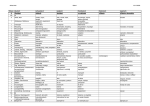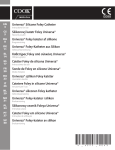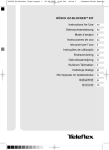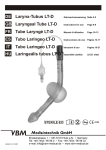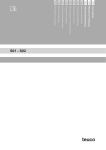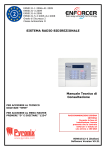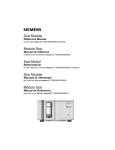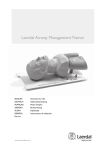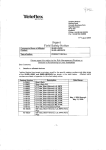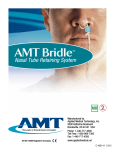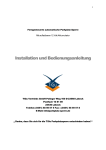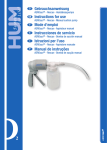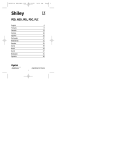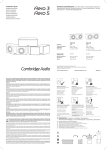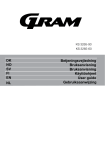Download G3046 LTS-D DE-GB-FR-ES-IT
Transcript
DE Larynx-Tubus LTS-D Gebrauchsanweisung Seite 2-5 GB Laryngeal Tube LTS-D Instructions for use Page 6-9 FR Tube Laryngé LTS-D Manuel d’utilisation Page 10-13 ES Tubo Laríngeo LTS-D Instrucciones de uso Página 14-17 IT Tubo Laringeo LTS-D Istruzioni d’uso Pagina 18-21 SE Laryngealtub LTS-D Bruksanvisning Sida 22-25 STERILE EO VBM Medizintechnik GmbH G3046-04 / 07.2007 2 Latex Einsteinstrasse 1 • DE-72172 Sulz a.N. • Germany Tel: +49 7454 / 95 96 0 • Fax: +49 7454 / 95 96 33 e-mail: [email protected] • www.vbm-medical.de 0123 Deutsch VBM Larynx-Tubus LTS-D Material: PVC Form und Design - latex frei - zum Einmalgebrauch - ermöglichen blindes Einführen - positionieren den LTS-D im Hypopharynx Normkonnektor Drainagekanal - farbcodiert für eine ein-fache Unterscheidung der unterschiedlichen Größen - für Magen- und Absaugsonde 18Fr Zahnmarkierungen - zur einfachen Orientierung und Repositionierung Belüftungszuleitung - belüftet und entlüftet beide Cuffs Proximaler Cuff - stabilisiert den Tubus und blockt Naso- und Oropharynx LTS-D Cuffs - sind großvolumig und passen sich optimal den anatomischen Gegebenheiten an Beatmung Tubus-Öffnungen - liegen dem Kehlkopfeingang gegenüber - ermöglichen Absaugung und Fiberbronchoskopie Druckentlastung Distaler Cuff - blockt den Ösophagus - reduziert die Möglichkeit der Mageninsufflation 10er Set, komplett mit 10 LTS-D, 1 farbkodierte Spritze und 1 Beißblock Größe Patient Patienten Größe 3 Erwachsene < 155cm 4 Erwachsene 155-180cm 5 Erwachsene > 180cm Konnektorfarbe gelb rot violett REF 32-06-003-1 32-06-004-1 32-06-005-1 Einzelset, komplett mit 1 LTS-D, 1 farbkodierte Spritze und 1 Beißblock Größe Patient Patienten Größe 3 Erwachsene < 155cm 4 Erwachsene 155-180cm 5 Erwachsene > 180cm Konnektorfarbe gelb rot violett REF 32-06-103-1 32-06-104-1 32-06-105-1 Notfall LTS-D Set, Bestehend aus 1 LTS-D Gr. 3, 4, 5, 1 farbkodierte Spritze und 1 Beißblock VBM 2 REF 32-06-209-1 Deutsch Gebrauchsanleitung Um den LTS-D sicher anwenden zu können, muss der Benutzer mit dieser Gebrauchsanweisung vertraut sein. Indikationen für die Anwendung des Larynx-Tubus Der Larynx-Tubus ist für die mechanische oder spontane Atmung bei Patienten während Anästhesien von kurzer Dauer, vorausgesetzt, die Patienten weisen ein geringes Aspirationsrisiko von Mageninhalten auf. Außerdem dient der Larynx-Tubus als alternatives Hilfsmittel zur Atemwegssicherung beim schwierigen Atemweg (European Resuscitation Council Guidelines for Resuscitation 2005, Section 4. Adult advanced life support). Kontraindikationen für die Anwendung des Larynx-Tubus LTS-D in elektiven Situationen Nicht nüchterne Patienten, inklusive Patienten, deren Nüchternheit nicht bestätigt werden kann sowie Situationen, wo die Möglichkeit für angestauten Mageninhalt besteht. Situationen, wo Mageninhalt präsent sein kann, sind u.a. starke oder krankhafte Fettleibigkeit, Schwangerschaft, vielfache oder schwerwiegende Verletzungen, akute Verletzung an Abdomen oder Thorax, jeglicher Umstand in Verbindung mit verzögerter Magenentleerung oder Anwendung von opiaten Medikamenten vor dem Fasten. Erwachsene, die Anweisungen nicht verstehen oder Fragen zu ihrer medizinischen Vorgeschichte nicht ausreichend beantworten können, da diese Patienten evtl. nicht für den Einsatz des LTS-D geeignet sind. Warnhinweise Der Anwender sollte bei der Anwendung des LTS-D mit folgenden Warnhinweisen vertraut sein: • Durch zu hohe Beatmungsdrücke können Gase sowohl in den Magen als auch in die Atmosphäre gelangen. • Nach der Platzierung suffiziente Beatmung am besten durch CO2-Messung oder durch Auskultation der Lunge und Thoraxbewegungen sicherstellen. • Der LTS-D ist ein Einmalprodukt und darf nicht wieder verwendet werden. Latexfrei Der LTS-D ist 100% latexfrei und daher für den Einsatz an Patienten mit Latexallergie geeignet. 1. Vorbereitungen zur Anwendung des Larynx-Tubus LTS-D Der Larynx-Tubus LTS-D ist steril solange die Verpackung verschlossen und unbeschädigt ist. Der LTS-D ist zum Einmalgebrauch bestimmt und darf nicht gereinigt oder wiederverwendet werden. Vor der Anwendung des LTS-D ist dieser dem nachfolgenden Leistungstest zu unterziehen: - Das Innere des Tubus auf lose Partikel und verengte Stellen untersuchen. - Die Cuffs belüften, um sie auf mögliche Undichtigkeiten zu untersuchen. Achtung: Undichte LTS-D dürfen nicht eingesetzt werden! 2. Anwendung des Larynx-Tubus LTS-D #2 10 20 30 40 LTS-D #4 LT #1 #0 LT LT #4 LT #5 LT #3 LT a) Die für den Patienten geeignete Größe des LTS-D wählen. 50 60 70 80 90 10 0 b) Beide Cuffs komplett entlüften und den Tubus ausreichend mit Gleitmittel auf wasserlöslicher Basis versehen. c) Ein Ersatz-LTS-D sollte für den sofortigen Einsatz bereitliegen. d) Vorherige Verabreichung von Sauerstoff ist in jedem Falle zu empfehlen. VBM 3 Deutsch e) Erreichen eines angemessenen Narkosestadiums Vor Einführen des LTS-D muss eine ausreichende Narkosetiefe gewährleistet sein. Bei der Einleitung der Narkose sollten Standard Überwachungstechniken angewendet werden. Generell beträgt die nötige Narkosetiefe nur wenig mehr als bei der Einführung eines Guedel-ähnlichen Tubus. Dem weniger erfahrenen Anwender wird die Wahl eines tieferen Narkosestadiums empfohlen. f) Positionieren des Kopfes Die ideale Kopfstellung zum Einführen des LTS-D wird durch eine erhöhte Kopflagerung erreicht. Jedoch ermöglichen die Kürze und die gebogene Form des Tubus, dass er auch in neutraler Kopfstellung eingeführt werden kann. g) Einführung des Larynx-Tubus LTS-D Um den LTS-D zu positionieren, muss eine Technik angewendet werden, welche die Anatomie berücksichtigt. Die folgende Gebrauchsanweisung ist daher zu beachten: • Es wird empfohlen, den LTS-D im Bereich der schwarzen Linien (Zahnmarkierungen) wie einen Stift zu halten. LTS #4 60 • Mit der freien Hand wird der Mund offen gehalten und sichergestellt, dass die Zunge während der Abwärtsbewegung des LTS-D nicht nach hinten fällt. Tubus nicht mit Gewalt einführen! cm O H2 • Den LTS-D mit der Spitze gegen den harten Gaumen des Patienten einführen. Den LTS-D sanft am Gaumen entlang mittig in den Hypopharynx schieben. Die mittlere schwarze Linie sollte nun auf Höhe der oberen Zähne liegen. Bei Problemen kann auch ein seitliches Einführen mit Drehbewegung hilfreich sein. 60 H 2O cm 1 LTS-D #4 #0 # LT LT LT #2 10 # LT 20 30 40 50 60 #5 #4 LT LT 3 70 80 90 0 10 • Die beiden Cuffs mit dem auf der Spritze markierten Volumen belüften. Durch die speziell entwickelte Ballonzuleitung wird dabei zuerst der proximale Cuff gefüllt, welcher den Tubus stabilisiert. Sobald sich dieser der Anatomie des Patienten angepasst hat, wird automatisch der distale Cuff belüftet. Empfohlenes Füllvolumen beachten: Größe 3 Größe 4 Größe 5 60 gea l-Tu be 70 20 80 Laryn Trac healT - 90 ube 100 0123 10 VBM 120 0 00 6 49 6 1 0 Cu H2 cmO f f Pressure Gaug 60 cmH2O 50 40 30 e LTS-D #4 VBM 4 60 ml 80 ml 90 ml • Bei elektiven Anwendungen, vor allem bei Spontanatmung, wird empfohlen, den LTS-D bis zum Konnektor einzuführen. Danach die Cuffs mit dem VBM Cuffdruckmessgerät „Universal“ auf 60cmH2O belüften und den Tubus an das Beatmungssystem anschließen. Während Betätigung des Atembeutels den Tubus gleichzeitig zurückziehen, bis eine widerstandsfreie Beatmung möglich ist (großes Tidalvolumen mit niedrigem Beatmungsdruck). Den Cuffdruck nochmals anpassen und kontinuierlich überwachen, um erhöhte Cuffdrücke zu vermeiden. Deutsch 60 • Der LTS-D ist nun platziert und der Patient kann beatmet werden. Erfolgreiche Beatmung durch Auskultation, Thoraxbewegungen und Kapnographie überprüfen. Ausschluss einer Magenblähung durch Inspektion, Palpation und Auskultation des Epigastriums. Bei unzureichender Beatmung kann der LTS-D zwischen den Zahnmarkierungen repositioniert werden. 2 cm H O LTS-D #4 Bei erfolgreicher Beatmung kann der LTS-D mit dem Beißblock fixiert werden. • Das Drainagelumen erlaubt das Einführen einer Magensonde oder eines Absaugkatheters max 18Fr. • Potentielle Probleme beim Einführen des Larynx-Tubus LTS-D Durch Hochziehen des Unterkiefers wird der Zungengrund angehoben und kann somit das Einführen des LTS-D erleichtern. Um die Tubusspitze beim Einführen zu stabilisieren, kann primär eine Magensonde in den Drainagekanal eingelegt werden. Magensonde nicht über die Austrittstelle ragen lassen und nach korrekter Tubusplatzierung vorschieben. Falls keine ausreichende Beatmung verifiziert werden kann, sollte der LTS-D zwischen den Zahnmarkierungen repositioniert werden. Es wird empfohlen, den LTS-D initial tiefer einzuführen und mit belüfteten Cuffs unter Beatmung langsam zurückzuziehen, bis eine widerstandsfähige Beatmung möglich ist (großes Tidalvolumen mit minimalem Beatmungsdruck). Durch das Zurückziehen des LTS-D mit belüfteten Cuffs wird außerdem Gewebe vom Kehlkopfeingang ferngehalten und verhindert, dass während Spontanatmung die Epiglottis oder Gewebe die Tubusöffnungen verschließen. Sollte dennoch keine ausreichende Beatmung erreicht werden, ist der LTS-D zu entfernen und der Luftweg mit anderen Hilfsmitteln aufrecht zu erhalten. Reicht die Narkosetiefe nicht aus, kann der LTS-D aufgrund anhaltender Schutzreflexe nicht eingeführt werden. In diesem Fall sollte die Narkose sofort vertieft und die manuelle Beatmung wieder aufgenommen werden. Um Trauma zu vermeiden, sollte zu keiner Zeit während der Einführung Kraft angewendet werden. i) Entfernen des LTS-D Wenn der LTS-D korrekt positioniert ist, wird er bis zur Rückkehr der Schutzreflexe gut toleriert. Der Cuffdruck sollte bei 60cmH2O beibehalten werden. 60 cm O H2 #0 #1 10 #2 20 LT 30 #3 LTS-D #4 LT LT LT 40 LT 50 #4 LT 60 #5 70 80 90 10 0 Achtung: Zum Entfernen des LTS-D müssen die Cuffs mit der beigefügten Spritze vollkommen entleert werden, da sie sonst beim Herausziehen des LTS-D beschädigt werden könnten. Den Tubus nur unter Absaug- und Intubationsbereitschaft entfernen. VBM 5 English Deutsch VBM Laryngeal Tube LTS-D Material: PVC Shape and design - latex free - for single use -Allow blind insertion without laryngoscopy - position LTS-D in the hypopharynx ISO Connector Drain Tube - color coded, for immediate identification of different sizes - for blind insertion of a 18Fr gastric catheter Teeth Marks - for orientation during insertion and repositioning Inflation Line - single lumen for inflation and deflation of both cuffs Proximal Cuff - stabilizes the tube and blocks oro- and nasopharynx LTS-D Cuffs - are high volume cuffs which adjust ideal to the anatomical situation Ventilation Ventilation Holes - lie in front of the larynx - allow suctioning and the passage of a fibreoptic bronchoscope Drain tube orifice Distal Cuff - blocks esophageal inlet - reduces possibility of gastric ventilation Box of 10, complete with 10 LTS-D, 1 color coded syringe and 1 biteblock Size Patient Patient Size 3 Adults < 155cm 4 Adults 155-180cm 5 Adults > 180cm Connector Color yellow red purple REF 32-06-003-1 32-06-004-1 32-06-005-1 Box of 1, complete with 1 LTS-D, 1 color coded syringe and 1 biteblock Size Patient Patient Size 3 Adults < 155cm 4 Adults 155-180cm 5 Adults >180cm Connector Color yellow red purple REF 32-06-103-1 32-06-104-1 32-06-105-1 Emergency LTS-D Set, Complete with 1 of each LTS-D size 3, 4, 5, 1 color coded syringe and 1 biteblock VBM 6 REF 32-06-209-1 English Instructions for Use In order to use the LTS-D safely the user must first be familiar with these instructions for use. Indications for the use of the Laryngeal Tube The Laryngeal Tube is intended for use in patients for controlled or spontaneous ventilation during anesthesia for procedures that are short in duration, when the patient is considered to have a low risk of aspiration of stomach contents. In addition the Laryngeal Tube is an alternative device to secure the airway during difficult airway management (European Resuscitation Council Guidelines for Resuscitation 2005, Section 4. Adult advanced life support). Contraindications for the use of the Laryngeal Tube LTS-D in elective situations Patients who have not fasted, including patients whose fasting cannot be confirmed, and in other situations where there may be retained gastric contents. Situations where gastric contents may be present include, but are not limited to, gross or morbid obesity, pregnancy, multiple or massive injury, acute abdominal or thoracic injury, any condition associated with delayed gastric emptying, or use of opiate medication prior to fasting. Adult patients who are unable to understand instructions or cannot adequately answer questions regarding their medical history, because these patients may be contraindicated for LTS-D use. Warnings The user should be familiar with the following warnings when considering or attempting to use the LTS-D: • High airway pressures may divert gas either to the stomach or to the atmosphere. • After placement, perform standard checks for breath sounds and utilize an appropriate carbon dioxide monitor as required by law or hospital protocol. • The LTS-D is a disposable product and cannot be reused. Latex-free The LTS-D is 100% latex-free and should be considered safe to use on patients who are latex sensitive. 1. Preparation for use of the Laryngeal Tube LTS-D The product is delivered in sterile condition unless the package is opened or damaged. The LTS-D is for single use only and therefore cannot be cleaned or reused. Before the use of the LTS-D the device must pass the following performance test: - Examine the interior of the airway tube to ensure that it is free from blockage or loose particles. - Inflate the cuffs to check for any possible leakage. Caution: Do not use the LTS-D if the cuff deflates. 2. Use of the Laryngeal Tube LTS-D #2 10 20 30 40 LTS II #4 LT #1 #0 LT LT #4 LT #5 LT #3 LT a) Choose the correct LTS-D size. 50 60 70 80 90 10 0 b) Check that both cuffs are completely deflated and that the LTS-D has been lubricated with water-soluble lubricant. c) Have a spare LTS-D ready and prepared for immediate use d) Pre-oxygenation is advisable in all cases VBM 7 English e) Achieve the appropriate depth of anesthesia An adequate level of anesthesia is required before the insertion of the LTS-D. Standard monitoring techniques should be followed when inducing anesthesia. In general, the depth of anesthesia needed is little more than that required for the insertion of a Guedel-type airway. It is recommended that the less experienced user choose a deeper level of anesthesia. f) Positioning the head The ideal head position for insertion is the “sniffing position”. However the shortness of the tube and the s-shape allows it to be inserted with the head in a neutral position. g) Insertion of the Laryngeal Tube LTS-D To position the LTS-D it is necessary to use a technique which takes the anatomy into account. Follow the instructions of use in the following sequence: • The recommended technique is to hold the LTS-D like a pen in the area of the black lines (teeth marks). LTS #4 60 • With the free hand, hold the mouth open and make sure that the tongue is not folded back during the downward movement of the LTS-D Never use force! O H2 cm • Place the flat edge of the LTS-D tip against the hard palate of the patient and slide it along the palate in the midline of the mouth down into the hypopharynx until the center black line is level with the upper teeth. In case of insertion problems a lateral insertion might be useful. 60 H 2O cm LTS II #4 #1 0 LT # LT # LT 2 10 LT 20 30 40 #4 LT #5 LT #3 50 60 70 80 90 10 0 • Inflate both cuffs with the volume which is indicated on the syringe. Due to the specially designed inflation line the proximal cuff is filled first which stabilises the tube. Once the proximal cuff has adjusted to the anatomy of the patient the distal cuff will be automatically inflated. Consider the recommended volumes: Size 3 Size 4 Size 5 Tube 60 70 Lare yng al-T ube Trac heal- 80 90 100 0123 10 VBM 120 00064961 0 Cu cmH2O f f Pressure Gaug 60 cmH2O 50 40 30 20 e LTS II #4 VBM 8 60 ml 80 ml 90 ml • In elective use, especially during spontaneous ventilation, it is recommended to advance the LTS-D to the connector. Then inflate the cuffs with the VBM Cuff Pressure Gauge “Universal” to 60cmH2O and attach the tube to the breathing circuit. While gently bagging the patient to assess ventilation, simultaneously withdraw the airway until ventilation is easy and free flowing (large tidal volume with minimal airway pressure). Re-adjust cuff pressure and monitor continuously to avoid excessive cuff pressures. English 60 • The LTS-D should now be properly positioned and the patient can be ventilated. Check lung ventilation by auscultation, capnography and chest movement. If ventilation is not sufficient, re-position the tube between the teeth marks. 2 cm H O LTS II #4 If efficient ventilation is achieved, the LTS-D can be fixed in position. The biteblock can do this, but is not required. • The drain tube allows the insertion of a gastric catheter max.18Fr Potential problems with inserting the LTS-D Jaw thrust or chin lift may help to advance the LTS-D because it lifts the base of the tongue. To stabilize the tip of the tube during insertion it is possible to primarily place a gastric catheter into the drain tube. The catheter should not protrude from the drain tube orifice and can be advanced after correct tube positioning. If no sufficient ventilation can be verified, re-position the LTS-D between the teeth marks. It is recommended to insert the LTS-D initially deeper. While gently bagging, slowly withdraw the tube with inflated cuffs until ventilation is easy and free flowing (large tidal volume with minimal airway pressure). Withdrawal of the LTS-D with inflated cuffs results in a retraction of tissue away from the laryngeal inlet and it prevents the epiglottis or other tissue to be drawn into the ventilation holes of the tube during spontaneous ventilation. If airway problems persist or ventilation is still inadequate, the LTS-D should be removed and an airway established by other means. An inadequate depth of anesthesia may result in coughing and breath holding during LTS-D insertion. Should this occur, the anesthesia should be deepened immediately and manual ventilation resumed. To avoid trauma, force should not be used at any time during insertion. i) Removal of the LTS-D Once it is in the correct position, the LTS-D is well tolerated until the return of protective reflexes. Intra-cuff pressures should be maintained around 60cmH2O. 60 cm O H2 #0 #1 10 #2 20 LT 30 #3 LTS II #4 LT LT LT 40 LT 50 #4 LT 60 #5 70 80 90 10 0 Note: For LTS-D removal, it is important that both cuffs are completely deflated with the included syringe to avoid cuff damage. Removal should always be carried out in an area where suction equipment and the ability for rapid intubation are present. VBM 9 Français Deutsch VBM Tube Laryngé LTS-D La forme et le design Matériau: PVC - permettent l’insertion en aveugle - positionnement du LTS-D dans l’hypopharynx - sans latex - à usage unique Raccord ISO - avec code couleur , pour identifier les tailles différentes facilement Canal d’aspiration - permet l’insertion d’une sonde d’aspiration taille Ch18 Tube de gonflage Marquage Arcades dentaires - gonfle et dégonfle les deux ballonnets en même temps - permet l’orientation et le repositionnement Ballonnet proximal - stabilise le tube en bloquant le naso- et oropharynx Les ballonnets du LTS-D - sont des ballonnets à grand volume et s’ajustent parfaitement à l’anatomie du patient Ventilation Orifices de ventilation - placées en face de l’orifice laryngé - permettent l’aspiration et la Fibroscopie Décharge de pression Ballonnet distal - bloque l’entrée de l’oesophage - réduit la possibilité d’une ventilation gastrique Boîte de 10, complet avec 10 LTS-D, 1 seringue avec code couleur et 1 cale-dents Taille Patient Taille du Patient Couleur du raccord 3 adulte < 155cm jaune 4 adulte 155-180cm rouge 5 adulte > 180cm violet REF 32-06-003-1 32-06-004-1 32-06-005-1 Boîte de 1, complet avec 1 LTS-D, 1 seringue avec code couleur et 1 cale-dents Taille Patient Taille du Patient Couleur du raccord 3 adulte < 155cm jaune 4 adulte 155-180cm rouge 5 adulte > 180cm violet REF 32-06-103-1 32-06-104-1 32-06-105-1 Kit LTS-D d’urgence, Avec un LTS-D de chaque taille 3, 4, 5, 1 seringue avec code couleur et 1 cale-dents REF 32-06-209-1 VBM 10 Français Mode d'emploi Pour l'utilisation du LTS-D, l'utilisateur doit bien connaître ce mode d'emploi. Indications pour l’utilisation du Tube Laryngé Le Tube Laryngé est indiqué pour la ventilation mécanique ou spontanée lors de l'anesthésie pendant des interventions de courtes durées, si le patient a un faible risque de régurgitation. De plus, le Tube Laryngé est un dispositif alternatif pour la prise en charge des voies aériennes pendant l’intubation difficile.(European Resuscitation Council Guidelines for Resuscitation 2005, Section 4. Adult advanced life support). Contre-indications à l'utilisation du Tube Laryngé LTS-D dans des situations électives Patients qui ne sont pas à jeun, inclus les patients pour lesquels il n'est pas sûr qu'ils soient à jeun, ainsi que pour d’autres situations s'il y a risque de rétention du contenu gastrique. Cas où le contenu gastrique pourrait être présent : obésité importante ou morbide, grossesse, blessures multiples ou massives, blessures de l'abdomen ou du thorax, chaque situation en association avec une évacuation retardée de l'estomac ou une utilisation de médicaments opiacés avant de jeûner. Ou bien adultes ne comprenant pas les instructions ou ne pouvant pas répondre aux questions concernant leur histoire médical, qui pourraient être contre-indiqués à l'utilisation du LTS-D. Avertissements L'utilisateur doit connaître les avertissements suivants avant d’utiliser le LTS-D : • En utilisant une pression de ventilation trop élevée on risque d'avoir des fuites de gaz non seulement dans l'estomac mais aussi dans l'atmosphère. • Après le positionnement du LTS-D il faut utiliser des techniques standards de contrôle comme le mouvement du thorax, en utilisant un moniteur CO2 adapté. • Le LTS-D est à usage unique et donc ne peut être réutilisé. Sans latex Le LTS-D est 100% sans latex, il est donc approprié pour des patients sensibles au latex. 1. Préparations à l'utilisation du LTS-D Le Tube Laryngé LTS-D est stérile tant que l’emballage est fermé et intact. Le LTS-D est à usage unique et ne doit pas être nettoyé ou réutilisé. Avant d’utiliser le LTS-D, il faut le soumettre au test de performances suivant : - Examiner l’intérieur du tube et vérifier l’absence de particules libres, ainsi que l’intégrité et la non obstruction des orifices de ventilation. - Pour examiner l’étanchéité des ballonnets, il faut les gonfler. Avertissement : Ne pas utiliser des LTS-D qui ne sont plus étanches ou qui présentent une anomalie visible! 2. Utilisation du Tube Laryngé LTS-D a) Assurez-vous que la taille du Tube Laryngé correspond au patient. #2 10 20 30 40 LTS II #4 #1 #0 LT LT LT #4 LT #5 LT #3 LT 50 60 70 80 90 10 0 b) Vider complètement les ballonnets et lubrifier le LTS-D avec une gelée type K.Y. c) Tenir prêt un LTS-D de rechange pour l'utilisation immédiate. d) Dans tous les cas, nous recommandons une pré-oxygénation systématique. VBM 11 Français Deutsch e) Atteindre un stade de profondeur d’anesthésie adéquate Avant d'insérer le LTS-D une anesthésie profonde doit être assurée. Pendant toute l'anesthésie appliquer des techniques de surveillance standards. En général, la profondeur de l'anesthésie nécessaire est identique à celle utile pour la pose d’un masque laryngé. Pour l'utilisateur moins expérimenté, il est recommandé de choisir une profondeur d'anesthésie plus importante. f) Positionner la tête La position idéale de la tête pour l'insertion du LTS-D est légèrement sur élevée. Cependant le tube court et sa forme en S permettent une insertion dans une position neutre de la tête. g) Insertion du Tube Laryngé LTS-D Pour positionner le LTS-D il faut utiliser une technique adaptée à l'anatomie cervicofaciale du patient. C'est pourquoi il est nécessaire de tenir compte du mode d'emploi suivant: • On recommande de tenir le LTS-D au niveau des marques noires (marques repères) comme un stylo. LTS #4 60 • Avec la main libre dégager le maxillaire inférieur vers le haut - et s'assurer que la langue ne tombe pas en arrière pendant le mouvement du LTS-D vers le bas. N'insérer pas le LTS-D avec force! cm O H2 • Pousser la partie inférieure du LTS-D avec l'extrémité douce contre le palais dur du patient. Faire glisser le LTS-D doucement en suivant le voile du palais et le mur postérieur centralement dans l'hypopharynx. Le marque repère au milieu doit maintenant être au niveau des dents. En cas de problèmes insérer le LTS-D en latéral en le tournant un peu. 60 H 2O cm #2 LTS II #4 #0 LT #1 LT LT 10 # LT 20 30 40 50 60 #5 #4 LT LT 3 70 80 90 10 0 • Gonfler les ballonnets au volume marqué sur la seringue. Le ballonnet proximal qui stabilise le LTS-D est remplit d'abord. Après qu'il soit adapté à l'anatomie du patient, le ballonnet distal est gonflé automatiquement et ceci grâce à une communication des canaux de gonflage. Attention: Noter les volumes de ballonnets suivants taille 3 taille 4 taille 5 al-Tu be 60 70 Lare yng al-T ube Trac he 80 90 100 0 12 3 10 VBM 120 0 00 6 49 6 1 0 Cu H2 cmO f f Pressure Gaug 60 cmH2O 50 40 30 20 e LTS II #4 VBM 12 60 ml 80 ml 90 ml • Pour des indications électives, surtout pour la ventilation spontanée, on recommande d'insérer le LTS-D jusqu'au raccord. Puis, de gonfler les ballonnets avec l'inflateur de pression à 60cm d'H2O et de brancher le tube au circuit de ventilation. En manipulant le ballon d'anesthésie, retirer le tube en même temps jusqu’à ce que la ventilation soit facile et sans résistance (grand volume tidale et pression de ventilation minimale). Ajuster la pression dans les ballonnets encore une fois et la vérifier en continu afin d'éviter une pression excessive. Français 60 • Le LTS-D est en place et le patient peut être ventilé. Vérifier la ventilation pulmonaire par capnographie, par auscultation du thorax et de l'estomac avec un stéthoscope. Vérifier l’absence de bruits hydroaériques en palpant et auscultant le creux épigastrique. Si la ventilation n’est pas suffisante, possibilité de repositionner le LTS-D entre le marque repère supérieure et inférieure. cm H 2 O LTS-D #4 Si la ventilation est suffisante, possibilité de fixer le LTS-D par le cale-dents. • Le canal d’aspiration permet l’insertion d’une sonde d’aspiration max. Ch18. • Problèmes potentiels pendant l'insertion du Tube Laryngé LTS-D Luxer la mâchoire pour dégager la base de la langue peut faciliter l’insertion du LTS-D. Il est possible de positionner une sonde gastrique dans le tube de drainage afin de stabiliser l’embout pendant l’insertion. La sonde ne doit pas dépasser du Tube et sera poussée une fois le Tube Laryngé en place. Si la ventilation n’est pas efficace, repositioner le LTS-D entre les marques de repaire dentaire. Il est, au départ, conseillé d’insérer le LTS-D plus profondément. Puis remonter doucement le LTS-D, ballonnets gonflés, jusqu’à l’obtention d’une ventilation correcte et fluide (large volume tidal et faible pression). Le fait de positioner le LTS-D en remontant, ballonnets gonflés, évite à l’épiglotte en particulier, mais aussi à d’autres tissus de venir s’insérer dans les orifices de ventilation du tube lors d’une ventilation spontanée. Si la ventilation est pourtant insuffisante, ôter le LTS-D et maintenir la ventilation avec une technique différente. Si la profondeur d'anesthésie ne suffit pas, le LTS-D ne peut pas être inséré. Dans ce cas, approfondir l'anesthésie immédiatement et reprendre la ventilation manuelle. Pour éviter un traumatisme, ne jamais forcer pendant l'insertion. i) Enlever le LTS-D Lorsque le LTS-D est correctement positionné, il est bien toléré jusqu’au retour des réflexes de déglutition. La pression dans les ballonnets doit être maintenue à 60cmH2O. c 60 m O H2 #0 #1 10 #2 20 LT 30 #3 LTS-D #4 LT LT LT 40 LT 50 #4 LT 60 #5 70 80 90 10 0 Attention: Les ballonnets doivent être complètement vides, sinon il y a possibilité de détérioration à la dépose. Enlever le LTS-D seulement quand on est prêt à aspirer et intuber. VBM 13 Español Deutsch VBM Tubo Laríngeo LTS-D Forma y diseño Material: PVC - permite intubación a ciegas - evita la irritación de las cuerdas vocales - posiciona el Tubo en la hipofarínge - libre de látex - de un solo uso Tubo de drenaje - para la inserción a ciegas de una sonda de 18Fr Conector de 15mm - de color, para mejor identificación de los diferentes tamaños Marcaciones de dientes - para fácil orientación y reposición Linea de inflado - para inflar y desinflar los balones Balones LTS-D - son de alto volumen y se ajustan perfectamente a la anatomía del paciente Balón proximal Ventilación - estabiliza el tubo y bloquea nasofaringe y orofaringe Orificios de ventilación - permanecen delante de la apertura glótica - permiten hacer la aspiración y la broncoscopia mediante fibroscopio Balón distal Tubo de drenaje - bloquea la entrada del esófago - reduce la posible ventilación al estómago Caja de 10 Unds., completo con 10x LTS-D, 1x jeringa codificada y 1x mordedor Tamaño Paciente Altura Código de color 3 Adulto <155cm amarillo 4 Adulto 155-180cm rojo 5 Adulto > 180cm violeta REF 32-06-003-1 32-06-004-1 32-06-005-1 Caja de 1 Und., completo con 1x LTS-D, 1x jeringa codificada y 1x mordedor Tamaño Paciente Altura Código de color 3 Adulto < 155cm amarillo 4 Adulto 155-180cm rojo 5 Adulto > 180cm violeta REF 32-06-103-1 32-06-104-1 32-06-105-1 Caja de emergencia LTS-D, completo con 1x LTS-D # 3, 4, 5, 1x jeringa codificada y 1x mordedor REF 32-06-209-1 VBM 14 Español Manual de uso Para poder utilizar el Tubo Laríngeo LTS-D de modo seguro, leer atentamente las siguientes páginas. Indicaciones para el uso del Tubo Laríngeo El Tubo Laríngeo está diseñado para el uso en ventilación mecánica o espontánea en anestesia de corto plazo y cuando se considere que el paciente tiene un bajo riesgo de aspirar el contenido gástrico, así como dispositivo alternativo para asegurar la vía aérea en vía aérea difícil. (European Resuscitation Council Guidelines for Resuscitation 2005, Section 4. Adult advanced life support). Contraindicaciones para el uso del Tubo Laríngeo LTS-D en situaciones electivas Pacientes que no han ayunado, incluidos aquellos cuyo ayuno no se puede confirmar, y aquellos que estén en otras situaciones en que pudiera existir contenido gástrico retenido. Situaciones en las que pudiera haber contenido gáste opiáceos antes del ayuno. Pacientes con hernia hiatal, al menos que se tomen medidas efectivas para vaciar el contenido estomacal con anterioridad. Pacientes adultos que no sean capaces de comprender las intrurico las que incluyen, entre otras, obesidad excensiva o mórbida, embarazo, lesiones múltiples o masivas, lesiones torácicas o abdominales agudas, cualquier afección asociada a la demora de la evacuación gástrica o el uso dcciones o que no puedan responder adecuadamente las preguntas relacionadas con su historial médico, ya que pueden haber contraindicaciones para el uso del Tubo Laríngeo. Advertencias El usario debe estar familiarizado con las siguientes advertencias al momento de considerar el uso del Tubo Laríngeo LTS-D: • La presión de las vías respiratorias superiores puede desviar gases hacia el estómago o hacia la atmósfera. • Despues de colocar el LTS-D controlar el movimiento del tórax y hacer el control y el monitoreo del Co2. • El LTS-D es de un solo uso y no puede ser esterilizado. Libre de látex El Tubo Laríngeo LTS-D es totalmente libre de látex y su uso es seguro en pacientes que tienen sensibilidad a este material. 1. Preparaciones para el uso del Tubo Laríngeo LTS-D a) Limpieza y desinfección El Tubo Laríngeo LTS-D está estéril siempre que el envase no esté abierto o dañado. El LTS-D es de un solo uso y no puede ser reesterilizado o reutilizado. Antes de utilizar el LTS-D debera ser sometido a las pruebas mencionadas a continuación: - Examinar el interior del tubo y verificar si el tubo y los orificios de ventilación no estan obstruidos. - Para examinar la función de los balones, deberan ser inflados Atención: No utilizar el LTS-D si los balones estan dañados. 2. Utilización del Tubo Laríngeo LTS-D #2 10 20 30 40 LTS II #4 #1 #0 LT LT LT #4 LT #5 LT #3 LT 50 60 70 80 90 a) Elegir el tamaño correspondiente. 10 0 b) Evacuar los balones completamente y lubricarlos bien. c) Tener al alcanze un LTS-D de recambio. d) Recomendamos hacer una preoxigenación en todo caso. VBM 15 Español Deutsch e) Conseguir una anestesia adecuada: Antes de introducir el LTS-D es necesario tener una anestesia profunda. Para conseguir una anestesia adecuada es necesario usar aparatos estándar. En general la anestesia es un poco mayor a la del uso con una cánula de Guedel. f) Posición de la cabeza: La posición ideal para la introducción del tubo es la posición elevada de la cabeza. El LTS-D tambien permite la introducción en posición neutral. g) Introducción del Tubo Laríngeo LTS-D: Para posicionar el LTS-D es necesario usar una técnica que tenga en consideración la anatomia del paciente. Seguir atentamente las instrucciones de uso a continuación: • Recomendamos sujetar el LTS-D como una pluma por encima del balón proximal. LTS #4 60 • Abrir la boca del paciente. Introducir el tubo en posición central hasta llegar la marcación central al nivel de los dientes del paciente. O H2 cm • Durante la introducción mantener la punta del LTS-D a lo largo del paladar y prestar atención de no empujar la lengua hacia dentro. • Inflar los balones con el manómetro de control a una presión de 60cmH2O. Gracias al nuevo sistema de inflado en primer lugar se infla el balón proximal, estabilizando así el LTS-D y después el balón distal. A continuación los volumenes para cada LTS-D: 60 H 2O cm 1 LTS II #4 #0 # LT LT # LT 2 10 # LT 20 30 40 50 60 #5 #4 LT LT 3 70 80 90 10 0 al-Tu be 60 70 Laryn gea l-Tub e Trac he 80 90 100 0123 10 VBM 120 00064961 0 Cu cmH2O f f Pressure Gaug e LTS II #4 VBM 16 60 ml 80 ml 90 ml • En uso electivo y en especial durante la ventilación espontanea, recomendamos introducir el LTS-D hasta el conector. Inflar los balones mediante el manómetro de Inflado “Universal” a una presión de 60cmH2O y conectar el LTS-D al circuito de ventilación. Durante el uso con la bolsa de respiración, tirar lentamente del tubo hasta conseguir una ventilación fácil y con poca resistencia (volumen tidal alto con presión ventilatoria baja). Reajustar nuevamente la presión en los balones y controlar de manera contínua para evitar presiones altas. 60 cmH2O 50 40 30 20 Tamaño 3 Tamaño 4 Tamaño 5 Español 60 • Iniciar la ventilación a través del conector de 15mm. Controlar la ventilación por auscultación del pulmón, capnografía y el movimiento del tórax. Si la ventilación no es suficiente, recomendamos reposicionar el LTS-D entre las marcaciones de los dientes. 2 cm H O LTS II #4 El protector antimordisco protege el LTS-D y permite una fijación segura. • El tubo de drenaje permite la inserción a ciegas de una sonda de max. 18Fr • Problemas potenciales en la inserción del Tubo Laríngeo LTS-D Elevando la mandíbula también se eleva la base de la lengua y puede facilitar así la inserción del tubo. Para estabilizar la punta del tubo durante la inserción es posible colocar antes una sonda nasogástrica en el canal de aspiración. La sonda no debe asomarse por el orificio del tubo y puede ser avanzada una vez que el tubo se encuentre en posición correcta. Si la ventilación no es eficaz, reposicionar el LTS-D entre las marcaciones dentales. En este caso es recomendable de insertar el LTS-D más profundo. Con los balones inflados y bajo ventilación retirar lentamente el LTS-D hasta obtener una ventilación buena y fluida (volumen tidal grande con presión mínima). La reposición del LTS-D con los balones inflados ayuda a retirar tejido de la entrada de la laringe y evita la oclusión de las aperturas del tubo por la epiglotis durante la ventilación espontanea. Si de todos modos la ventilación sigue siendo insuficiente el LTS-D debe ser cambiado por un tamaño mayor. Si la anestesia no es suficientemente profunda la introducción del LTS-D puede provocar problemas. En este caso se deberá de poner la anestesia más profunda y ventilar al paciente manualmente. i) Retirar el LTS-D Una vez que el LTS-D este en posición correcta y las presiones se hayan establecido alrededor de una presión media de 60cmH2O, el LTS-D es relativamente bien tolerado de los pacientes antes de recuperar los reflejos. 60 O H2 cm #0 #1 10 #2 20 LT 30 #3 LTS II #4 LT LT LT 40 LT 50 #4 LT 60 #5 70 80 90 10 0 Atención: Desinflar completamente los balones mediante la jeringa adjunta antes de retirar el LTS-D. De esta forma quedarán llos balones protegidos. Retirar el tubo teniendo al alcanze un sistema de succión y material para la intubación. VBM 17 Italiano VBM Tubo Laringeo LTS-D Materiale: PVC Forma e design - privo di lattice - monouso - consente l’inserimento alla cieca senza L’ausilio del laringoscopio - viene posizionato nell’ipofaringe Canale di drenaggio - per l’inserimento alla cieca di un sondino di aspirazione gastrica da 18Fr Raccordo ISO - provvisto di codice colore per l'immediata identificazione delle diverse misure disponibili Markers di riferimento - per l’orientamento durante l’introduzione Linea di gonfiaggio - unico canale per il gonfiaggio e lo sgon-fiaggio di entrambe le cuffie Cuffie LTS-D - entrambe sono ad ampio volume e si adattano per-fettamente alle diverse conformazioni Cuffia prossimale - stabilizza il tubo e blocca l’oro-nasofaringe Ventilation Fori di ventilazione - posizionati fronte laringe - permettono l’aspirazione ed il passaggio di un fibrobroncoscopio Cuffia distale - blocca l’ingresso esofageo - riduce la possibilità di una ventilazione gastrica Foro di drenaggio Scatola da 10 pz., completa di 10 LTS-D, 1 siringa con codice colore ed 1 biteblock Misura Paziente Altezza e Peso Codice colore ART. 3 4 5 adulti adulti adulti < 155 cm 155-180 cm > 180 cm giallo rosso viola 32-06-003-1 32-06-004-1 32-06-005-1 Scatola da 1 pz., completa di 1 LTS-D, 1 siringa con codice colore ed 1 biteblock Misura Paziente Altezza e Peso Codice colore ART. 3 4 5 adulti adulti adulti < 155 cm 155-180 cm > 180 cm giallo rosso viola 32-06-103-1 32-06-104-1 32-06-105-1 Conf. 1 1 1 Conf. 1 1 1 Set di emergenza LTS-D, completo di 1 LTS-D per ciascuna misura (3, 4 e 5) 1 siringa con codice colore ed 1 biteblock ART. 32-06-209-1 VBM 18 Italiano Istruzioni per l’uso Prima di utilizzare il tubo LTS-D, leggere attentamente le istruzioni d'uso. Indicazioni per l’uso del tubo laringeo Tubo laringeo è indicato per l’anestesia d’elezione durante interventi di breve durata in ventilazione spontanea o controllata. È importante che il paziente sia considerato con basso rischio di aspirazione gastrica. Il tubo laringeo è inoltre un dispositivo alternativo che garantisce la ventilazione delle vie aeree in situazioni che presentano difficoltà respiratorie. (European Resuscitation Council Guidelines for Resuscitation 2005, Section 4. Adult advanced life support). Contraindicazioni per l’uso del tubo laringeo LTS-D in condizioni elettive Pazienti che non sono a digiuno, inclusi quelli per i quali il digiuno non può essere confermato e in altre circostanze per le quali possono essere trattenuti contenuti gastrici. Situazioni nelle quali i contenuti gastrici possono essere presenti ma non limitati a causa di un'obesità, una gravidanza, lesioni multiple o massive, lesioni toraciche o addominali acute, qualsiasi altra condizione associata allo svuotamento gastrico ritardato oppure all'uso di farmaci oppiacei prima del digiuno. Pazienti adulti incapaci di comprendere le istruzioni o che non sono in grado di rispondere adeguatamente alle domande riguardanti la propria anamnesi. Avvertimenti Per poter utilizzare il tubo laringeo LTS-D in modo sicuro, leggere attentamente le seguenti avvertenze: • Pressioni elevate delle vie aeree possono deviare i gas all'interno dello stomaco o nell'ambiente • Dopo il posizionamento, procedere con i normali controlli respiratori ed utilizzare un apparecchio adatto per il monitoraggio dell'ossido di carbonio, come indicato dal protocollo ospedaliero. • LTS-D è un dispositivo monouso e non può essere riutilizzato. Privo di lattice LTS-D è privo di lattice e quindi sicuro per l’uso con pazienti che sono sensitivi al lattice. 1. Preparazione per l’uso del Tubo Laringeo LTS-D Il presidio viene fornito in confezione sterile e la sua sterilità è garantita solo se la confezione è integra e non risulta danneggiata. Prima dell'uso, il Tubo Laringeo deve essere sottoposto ai seguenti controlli: - Controllare che il canale interno del tubo sia perfettamente pervio e che non sia quindi ostruito da corpi estranei - Gonfiare le cuffie al fine di verificare eventuali perdite delle cuffie. Attenzione: se la cuffia si sgonfia, non utilizzare l'LTS-D 2. Utilizzo del tubo laringeo LTS-D #2 10 20 30 40 LTS II #4 LT #1 #0 LT LT #4 LT #5 LT #3 LT a) Scegliere la misura corretta del LTS-D. 50 60 70 80 90 10 0 b) Controllare che entrambe le cuffie siano completamente sgonfie e lubrificarle. c) Tenere a portata di mano un LTS-D di sostituzione in ogni caso. d) È consigliabile la pre-ossigenazione in ogni caso. VBM 19 Italiano e) Eseguire un adeguata anestesia Prima di inserire il LTS-D, è necessario portare il paziente ad un adeguato livello di anestesia durante il quale è bene seguire le tecniche di monitoraggio standard. Solitamente la profondità dell’anestesia necessaria è poco più di quella richiesta per l’inserimento di una cannula di Guedel. Per un utilizzatore poco esperto, si consiglia di scegliere un livello di anestesia più profondo. f) Posizione della testa La posizione ideale della testa è quella della testa elevata. Tuttavia, grazie alla lunghezza ridotta del tubo ed alla sua angolazione, è possibile procedere con l’inserimento del LTS-D qualunque sia la posizione della testa del paziente. Non è quindi indispensabile l’estensione. g) Inserimento del tubo laringeo LTS-D Per posizionare il LTS-D è necessario utilizzare una tecnica che prenda in considerazione l'anatomia. Seguire attentamente le istruzioni riportate qui di seguito: • Si consiglia di tenere il tubo tra le dita come se fosse una penna, a livello del marker nero di riferimento. LTS #4 O H2 cm 60 Con la mano libera, tenere aperta la bocca del paziente ed assicurarsi che la lingua non venga spinta all'indietro durante la manovra di inserimento. Mai esercitare forza! • Posizionare la parte piatta della punta del tubo contro il palato e farla scivolare all'interno della cavità orale fino a posizionare la linea di marker mediana a livello dell'arcata dentaria superiore. In caso di difficoltà di intubazione, potrebbe essere utile un'intubazione laterale. 60 H 2O cm 1 LT LTS II #4 #0 # LT LT #2 10 # LT 20 30 40 50 60 #5 #4 LT LT 3 70 80 90 0 10 • Gonfiare entrambe le cuffie con il volume indicato sulla siringa. Grazie alle speciale linea sequenziale, la cuffia prossimale sarà la prima a gonfiarsi per stabilizzare il tubo. Una volta che la cuffia prossimale si è ben adattata alla conformazione anatomica del paziente, la cuffia distale si gonfierà automaticamente. Prestare attenzione ai volumi indicati qui di seguito: Misura 3 Misura 4 Misura 5 60 70 Laryn gea l-Tub e Trac heal-T ube 80 90 100 0123 10 VBM 120 00064961 0 Cu cmH2O f f Pressure g G au 60 cmH2O 50 40 30 20 e LTS II #4 VBM 20 60 ml 80 ml 90 ml • Nell'anestesia di elezione si consiglia di inserire il LTS-D più in profondità. Gonfiare le cuffie a 60 cmH2O con il manometro “Universal“. Durante la ventilazione, ritrarre lentamente il tubo con le cuffie gonfie fino a che la ventilazione avvenga liberamente (un ampio volume tidalico con una minima pressione sulle vie aeree). Misurare la pressione continuamente per evitare pressione eccessiva nelle cuffie. Italiano 60 • A questo punto il tubo laringeo è posizionato ed il paziente può essere ventilato. Controllare la ventilazione polmonare mediante auscultazione, capnografia e seguendo il movimeto del torace. Nel caso in cui la ventilazione non fosse sufficiente, spostare il tubo in direzione distale o prossimale in base alla linea di marker mediana. 2 cm H O LTS II #4 Utilizzando il biteblock incluso, il tubo laringeo può essere protetto e fissato in modo sicuro. • Il canale di drenaggio consente l’inserimento di un sondino da mass. 18Fr • Problemi potenziali con l’inserimento del tubo laringeo LTS-D Alzando la mascella, la base della lingua viene sollevata e ciò facilita notevolmente l'avanzamento del Tubo Laringeo LTS-D. Per stabilizzare la punta del tubo durante l'inserimento, è possibile posizionare in primo luogo un sondino gastrico all'interno del canale di drenaggio. Il sondino non deve però sporgere dal lume del canale di drenaggio e può essere fatto avanzare dopo un corretto posizionamento del tubo. Se la ventilazione non è sufficiente, posizionare nuovamente il LTS-D tra i markers neri. Inizialmente si consiglia di inserire il LTS-D più in profondità. Durante la ventilazione, ritrarre lentamente il tubo con le cuffie gonfie fino a che la ventilazione avvenga liberamente (un ampio volume tidalico con una minima pressione sulle vie aeree). Se persistono problemi alle vie aeree o la ventilazione continua ad essere inadeguata, il LTS-D deve essere rimosso e la funzione delle vie aeree ripristinata con altri mezzi. Se l’anestesia somministrata dovesse essere inadeguata, è facile riconoscerlo dalla presenza del colpo di tosse o dal respiro trattenuto durante l’inserimento del LTS-D. Qualora ciò si verificasse, è necessario somministrare immediatamente un’anestesia più profonda e procedere con una ventilazione manuale. Per evitare traumi, non esercitare alcun tipo di forza durante l’inserimento. I) Rimozione del tubo LTS-D Una volta raggiunta la posizione corretta, l'LTS-D è ben tollerato fino al ripristino dei riflessi di protezione , fermo restando che la pressione interna delle cuffie sia mantenuta costante sui 60 cmH2O. 60 O H2 cm #0 #1 10 #2 20 LT 30 #3 LTS II #4 LT LT LT 40 LT 50 #4 LT 60 #5 70 80 90 10 0 Attenzione: Per la rimozione del tubo LTS-D entrambe le cuffie devono essere completamente sgonfie utilizzando la siringa inclusa nel kit. La rimozione deve avvenire sempre in un ambiente attrezzato nel quale vi siano strumenti per aspirare ed intubare rapidamente . VBM 21 Svenska VBM Laryngealtub LTS-D Form och design - möjliggör blind intubation utan laryngoscop - positionerar LTS-D i hypopharynx Dräneringstub - för blind nerförsel av verntrikelsond max 18Fr ISO connektor - färgkodad för snabb storleksidentifiering Tandmarkering - för lägesbestämning vid insättning Cuffslang med backventil - singellumen för fyllning och tömning av båda cuffarna samtidigt Material: PVC - latexfri - för engångsbruk LTS-D Cuffarna - högvolymskuffar som formar sig perfekt till den anatomiska situationen Proximal Cuff - stabiliserar tuben och blockerar uppåt mot oro-och nasopharynx Ventilation Ventileringshål - ligger i höjd med larynx - tillåter sugning och fiberoptisk bronchoscopi Dränagetubsmynning Distal Cuff - blockerar porten till oesophagus - reducerar risken för oesophagusventilation Box med 10st, komplett med 10st LTS-D, 1st färgkodad spruta och 1st bitblock Storlek Patient Patient vikt/längd Färgkod konnektor 3 Vuxen < 155cm längd gul 4 Vuxen 155-180cm röd 5 Vuxen > 180cm längd lila Art,nr 32-06-003-1 32-06-004-1 32-06-005-1 Box 1 1 1 Box med 1st, komplett med 1st LTS-D, 1st färgkodad spruta och 1st bitblock Storlek Patient Patient vikt/längd Färgkod konnektor 3 Vuxen < 155cm längd gul 4 Vuxen 155-180cm röd 5 Vuxen > 180cm längd lila Art,nr 32-06-103-1 32-06-104-1 32-06-105-1 Box 1 1 1 Akutset LTS-D Komplett med 1st av vardera LTS-D storlek 3,4 och 5, 1st färgkodad spruta och 1st bitblock 32-06-209-1 VBM 22 Svenska Bruksanvisning För att använda LTS-D på ett säkert sätt måste användaren känna till följande instruktion. Indikation för användande av Laryngealtub LTS-D LTS-D är avsedd att användas på patient vid kontrollerad eller spontan ventilation under kortare tid och där patienten bedöms ha låg risk för aspiration av maginnehåll. Dessutom är LTS-D ett alternativ för att säkra luftvägen vid behandling av svår luftväg (European Resuscitation Council Guidelines for Resuscitation 2005, Section 4. Adult advanced life support). Kontraindikationer för användning av Laryngealtub LTS-D i elektivt bruk Patienter som inte är fastande eller där fastetiden inte kan fastställas samt i andra situationer där det finns risk för kvarvarande maginnehåll. Sådana situationer och tillstånd kan vara, men är inte begränsade till, extrem fetma, graviditet, multipel eller massiv skada, akut buk eller thoraxskada, alla tillstånd som kan sammankopplas med försenad magtömning, samt bruk av opiater före fastetidens inledning. Vuxna patienter som inte är i stånd att svara adekvat på frågor angående sin medicinska historia eller inte är i stånd att förstå instruktioner kan av dessa anledningar var kontraindicerade för LTS-D-bruk. Varningar Användaren skall känna till följande varningar innan han använder eller överväger att använda LTS-D: • Högt luftvägstryck kan skapa gasläckage antingen mot magsäcken eller ut i atmosfären. • Utför kontroll av andningsljud och CO2 monitorering enligt den standard som gäller, antingen lagstadgad eller som lokal instruktion, efter nersättning. • LTS-D är en engångsprodukt och kan inte återanvändas Latexfri LTS-D är till 100% latexfri och skall anses som säker vid användning på latexöverkänsliga patienter. 1. Förberedelser för användande av Laryngealtub LTS-D Produkten levereras steril förutsatt att emballaget är oöppnat och oskadat. LTS-D är en engångsprodukt och kan därför inte rengöras, steriliseras eller återanvändas. Före varje användande av LTS-D måste produkten klara följande kontroll: - kontrollera innerlumen så den är fri från lösa eller blockerande partiklar. - fyll cuffarna för att upptäcka eventuellt läckage. Observera: Använd inte LTS-D om cuffarna inte håller trycket 2. Användning av Laryngealtub LTS-D #2 10 20 30 40 LTS II #4 LT #1 #0 LT LT #4 LT #5 LT #3 LT a) Välj rätt storlek på LTS-D 50 60 70 80 90 10 0 b) Kontrollera att båda cuffarna är helt tömda och att LTS-D har blivit smord med vattenlösligt glidmedel c) Ha en reserv LTS-D redo och preparerad för omedelbart bruk d) Preoxygenisering rekommenderas alltid VBM 23 Svenska e) Uppnå lämpligt anestesidjup En adekvat anestesinivå är nödvändig innan nersättning av LTS-D. Standardmonitorering skall följas vid anestesiinduceringen. Det behövs generellt något mer anstesidjup än vid nersättande av svalgtub. Mindre erfarna användare rekommenderas välja en något djupare anestesinivå. f) Positionering av huvudet Den idealiska positionen för nersättning är ”sniffposition”. Tubens längd och s-form tillåter nersättning med huvudet i neutral position. g) Nersättande av LTS-D För att positionera LTS-D rätt är det viktigt att ta anatomin i beaktande. Följ bruksanvisningens följande sekvenser. • Rekommenderad teknik är att hålla LTS-D som en penna i höjd med de svarta linjerna (tandmarkeringarna) LTS #4 60 Håll munnen öppen med den fria handen och försäkra dig om att tungan inte följer med bakåt under nersättningen av LTS-D. Använd aldrig våld! H cm O 2 • Placera den flata delen av spetsen på LTS-D mot hårda gommen på patienten och låt den glida utmed gommen i medellinjen av munnen ner till hypopharynx tills den grova svarta tandmarkeringen står i höjd med övertänderna. Om nersättningsproblem uppstår kan en lateral nersättnings-teknik vara användbar. 60 H 2O cm LTS II #4 #1 0 LT # LT # LT 2 10 LT 20 30 40 #4 LT #5 LT #3 50 60 70 80 90 10 0 • Fyll de båda kuffarna med den volym luft som finns markerat på den medföljande sprutan. Tack vare den specialutformade cufflinjen fyller sig först den proximala cuffen för att stabilisera tuben. När den proximala cuffen format sig efter patientens anatomi fyller sig den distala cuffen automatiskt. Observera följande volymer Storlek 3 Storlek 4 Storlek 5 60 70 Laryn gea l-Tub e Trac heal-T ube 80 90 100 0123 10 VBM 120 0 00 6 49 6 1 0 Cu H2 cmO f f Pressure Gaug 60 cmH2O 50 40 30 20 e LTS II #4 VBM 24 60ml 80ml 90ml • Vid elektivt bruk, särskilt vid spontanandning, rekommenderas att tuben nerförs till connektorn. Fyll därefter cuffarna till 60cmH2O med Cufftrycksmätare VBM Universal och koppla tuben till andningscirkeln. Ventilera patienten varsamt samtidigt som tuben backas till ett läge där ventilationen går lätt och fritt (hög tidalvolym och minimalt luftvägstryck). Rejustera cufftrycket och monitorera det kontinuerligt för att undvika överdrivet cufftryck. Svenska • LTS-D bör nu vara i korrekt position och patienten kan nu ventileras. Kontrollera lungventilationen med auskultation, capnograf och via bröströrelse. 60 Om ventilationen inte är tillfredsställande justera tubens läge inom tandmarkeringarna. När ventilationen är effektiv kan LTSD fixeras. 2 cm H O LTS II #4 • Dräneringstubens lumen medger nerförande av cateterstorlek 18 Fr. • Potentiella problem vid nersättning av LTS D Käklyft som lyfter upp tungbasen kan underlätta nerförandet av tuben. För att stabilisera tubspetsen kan en kateter i förväg placeras i tubens sugport. Katetern skall inte gå utanför sugportsmynningen, och kan sedan föras ner i oesophagus när tuben är korrekt placerad. Repositionera LTS-D mellan tandmarkeringarna om tillfredsställande ventilation inte kan verifieras. Det är rekommendabelt att initialt föra ner LTS-D något djupare. Fyll därefter cuffarna och ventilera försiktigt samtidigt som tuben backas till ett läge där ventilationen går lätt och fritt (hög tidalvolym och minimalt luftvägstryck). Att backa LTS-D med fyllda cuffar gör att vävnad förs undan från laryngealporten och hindrar epiglottis och annan vävnad från att sugas in mot ventilationshålen under spontanandning. Om problemen kvarstår eller ventilationen inte är tillfredsställande skall LTS-D avlägsnas och luftvägen säkras på annat sätt. Ett inadekvat anestesidjup kan resultera i hostning och apne under nersättandet av LTS-D. Om detta inträffar skall anestesidjupet snarast ökas och patienten ventileras manuellt. För att förhindra trauma får våld eller överdriven kraft aldrig användas under någon del av nersättandet. h) Avlägsna LTS-D Når LTS-D är i korrekt position är den väl tolererad tills skyddsreflexerna återvänder. Cufftrycket skall hållas runt 60cmH2O. 60 O H2 cm #0 #1 10 #2 20 LT 30 #3 LTS II #4 LT LT LT 40 LT 50 #4 LT 60 #5 70 80 90 10 0 Observera: Vid avlägsnande av LTS-D är det alltid viktigt att cuffarna ä helt tömda med den medföljande sprutan för att undvika skador på cuffarna. Avlägsnande skall alltid ske där det finns tillgång till sug och möjlighet till snabb intubering. VBM 25




























